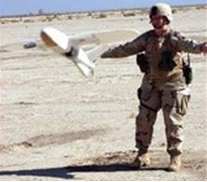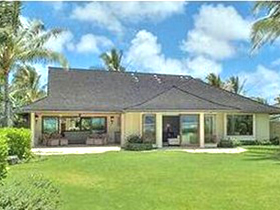

The glamour of their “piloting” job may not match that of F-15 Eagle or F-16 Fighting Falcon “fighter jocks.”
But a group of enlisted Security Forces Airmen here are using their wings to do a job both kinds of pilots do -- provide base security through air superiority.
The half-dozen Airmen -- 407th Expeditionary Security Forces Squadron troops -- pilot tiny unmanned aerial reconnaissance vehicles that provide low-cost, low-risk video of any terrain over which they fly.
To these force protection airborne surveillance system team “cop-pilots,” flying the MQ-1 Predator’s “Mini Me” counterpart is no hobby.
The tiny planes transmit real-time data -- day or night -- to a ground based operator (the pilot) for analysis and risk assessment. The second operator (the co-pilot) does the pre-launch checks and provides launch assistance.
A portable computer controls the UAVs flight controls and flight paths until the pilot spots trouble and switches to “U-drive,” and takes control from the computer. “This isn’t what people think it is. It isn’t a toy and it’s not just a remote controlled plane,” said Senior Airman Shawn Fernandez, a team pilot.
Team members are hand-picked for the job at their home stations and attend specialized training to operate the UAVs before deploying.
The teams can cover a lot of ground with their UAVs. Plus using them costs less and is less risky than using manned ground patrols.
“This is a really great system,” team member Senior Airman JoAnn Bonzi said. “It allows us to cover a lot of territory that would be hard, if not impossible, to keep an eye on properly any other way.”
After a team parks its vehicle at pre-assigned locations, it launches the UAV for the mission. How long the UAV is in the air depends on the assigned flight path and environmental conditions.
The UAV is almost silent as it goes about its business. And like a U-2 reconnaissance aircraft flying many thousands of feet higher, this mini-UAV’s imagery allows a trained operator to spot any kind of potentially aggressive situations, setups or enemy.
“Every [Airman]here plays a part in base defense -- especially security forces. This (UAV operations) is just one part of it. But it’s a great part to be involved in,” said Airman 1st Class Eric Vaughn, another team member.
The UAV operators are called pilots and co-pilots in part because of shared responsibilities they have with traditional fliers. Just like a manned flight, UAV pilots and co-pilots have to notify the air control tower about their location, get clearance to launch and check the flying weather forecast before a mission.
Staff Sgt. Chenoa Abbott is the noncommissioned officer in charge of the team. She said flying the UAVs is “really a different role for a person from security forces to take on.”
But she said, “It has really opened my eyes and given me a chance to see what the skies of the Air Force are really like.”



















